
Power steering. Service and faults
Content
- Functions and purpose of power steering
- The principle of operation of the power steering
- Power steering device
- Types of power steering
- Maintenance
- Frequency of fluid replacement in power steering
- Basic malfunctions and methods of elimination
- Advantages and Disadvantages of Power Steering
- Questions and answers:
A modern car cannot be imagined without systems that improve ride comfort. These systems include the power steering.
Consider the purpose of this mechanism, the principle of its operation and what malfunctions are.
Functions and purpose of power steering
As the name suggests, power steering is used in a car's steering gear. Power steering enhances the driver's actions during the maneuver of the machine. Such a system is installed in trucks so that the driver can turn the steering wheel at all, and a passenger car is equipped with this mechanism to increase comfort.
In addition to lightening efforts when driving, the hydraulic booster allows you to reduce the number of full turns of the steering wheel to achieve the required position of the front wheels. Machines that do not have such a system are equipped with a steering rack with a large number of teeth. This makes it easier for the driver, but at the same time increases the number of full turns of the steering wheel.
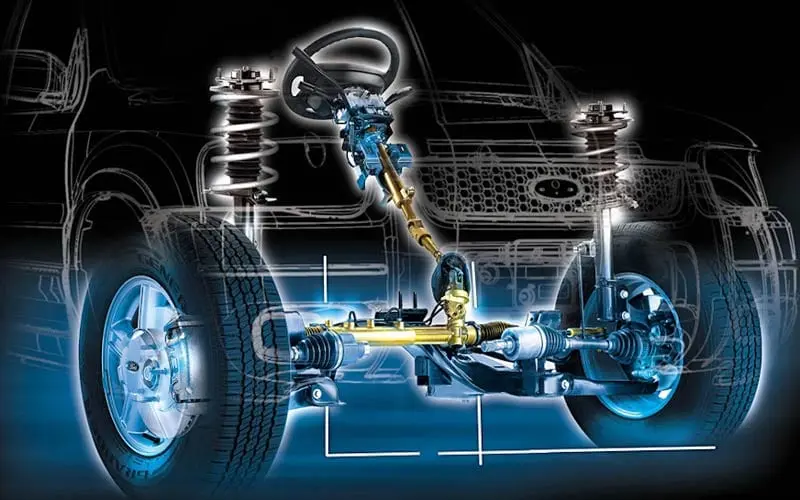
Another purpose of power steering is to eliminate or mitigate the impacts that go to the steering wheel from the drive wheels when the car is driving on a poorly surfaced road or when it hits an obstacle. It often happens when in a car without this auxiliary system, when driving, the steering wheel was simply pulled out of the driver's hands when the wheels hit a large unevenness. This happens, for example, in winter when driving on a deep rut.
The principle of operation of the power steering
So, the power steering is needed to make it easier for the driver to maneuver the car. This is how the mechanism works.
When the car engine is running, but does not go anywhere, the pump pumps fluid from the reservoir to the distribution mechanism and back in a closed circle. As soon as the driver begins to turn the steering wheel, a channel opens in the distributor corresponding to the steering side.
The liquid begins to flow into the cavity of the hydraulic cylinder. On the back of this container, the power steering fluid moves into the tank. The movement of the steering rack is facilitated by the movement of the rod attached to the piston.
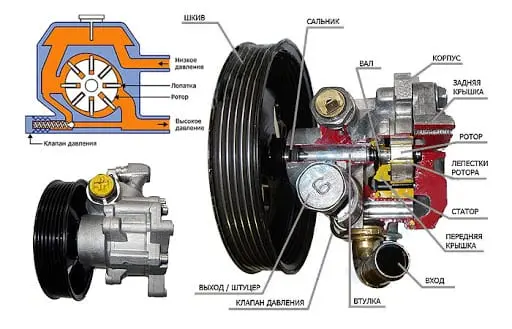
The main requirement for steering a vehicle is to ensure that the steering wheels return to their original position after a maneuver when the driver releases the steering wheel. If you hold the steering wheel in the turned position, the steering rack turns the spool. It is aligned with the camshaft drive shaft.
As no more forces are applied, the valve aligns and stops acting on the piston. The mechanism stabilizes and starts to idle, as if the wheels were straight. The power steering oil circulates unhindered along the highway again.
When the steering wheel is in the extreme left or right side (all the way), the pump is loaded to its maximum, because the distributor is no longer in the optimal position. In this situation, the liquid begins to circulate in the pump cavity. The driver can hear that the pump is working in enhanced mode by a characteristic squeak. To make the system easier to work, just let go of the steering wheel a little. Then free movement of fluid through the hoses is ensured.
The following video explains how the power steering works:
Power steering device
The power steering system is designed so that even if it completely fails, the car can still be safely driven. This mechanism is used in almost any type of steering. The most common application is received by rack systems.
In this case, the gur consists of the following elements:
- Reservoir (similar to an expansion tank for a cooling system or brakes);
- Power steering pump;
- Power steering distributor;
- Hydraulic cylinders;
- High and low pressure connecting hoses.
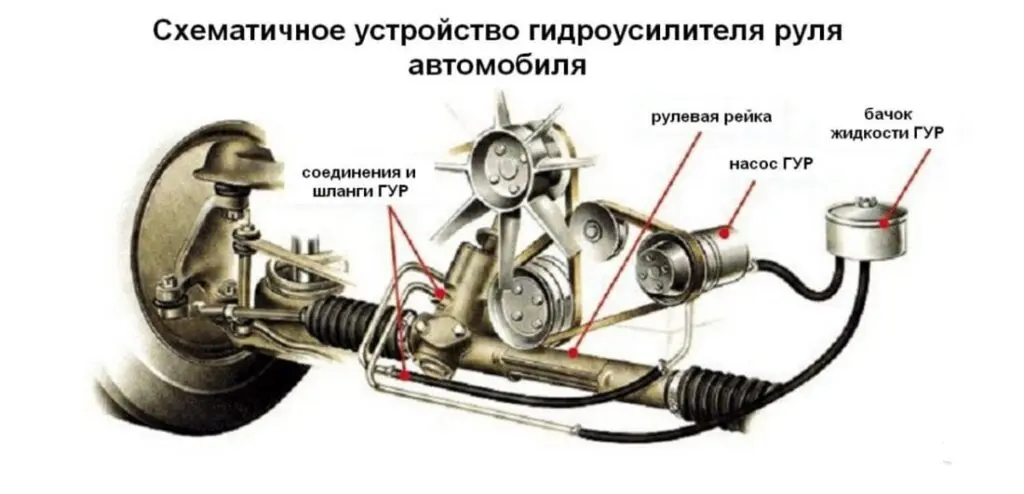

Tank GUR
A reservoir is a reservoir from which oil is sucked in by the pump for the operation of the mechanism. The container has a filter. It is needed to remove chips and other solid particles from the working fluid, which can interfere with the operation of some elements of the mechanism.
To prevent the oil level from dropping to a critical value (or even lower), the reservoir has a hole for the dipstick. The hydraulic booster fluid is oil-based. Due to this, in addition to the required pressure in the line, all elements of the mechanism are lubricated.
Sometimes the tank is made of transparent, durable plastic. In this case, the dipstick is not needed, and a scale with the maximum and minimum oil level will be applied to the wall of the tank. Some mechanisms require a short system operation (or several turns of the steering wheel to the right / left) to determine the exact level.


The dipstick, or in the absence of one, the tank itself, often has a double scale. On one part, indicators for a cold engine are indicated, and on the second for a warmed one.
Power steering pump
The function of the pump is to ensure constant circulation of oil in the line and create a pressure to move the piston in the mechanism. In most cases, manufacturers equip cars with a vane pump modification. They are attached to the cylinder block. A timing belt or a separate pump drive belt is put on the pulley of the device. As soon as the motor starts running, the pump impeller also starts rotating.
The pressure in the system is created by the speed of the motor. The greater their number, the more pressure is created in the hydraulic booster. To prevent excessive pressure build-up in the system, the pump is equipped with a relief valve.
There are two modifications of power steering pumps:
- Adjustable. This modification maintains a stable pressure in the line due to a change in the working volume of the device;
- Unregulated. Such modifications are equipped with a pressure reducing valve that maintains a stable pressure in the line.
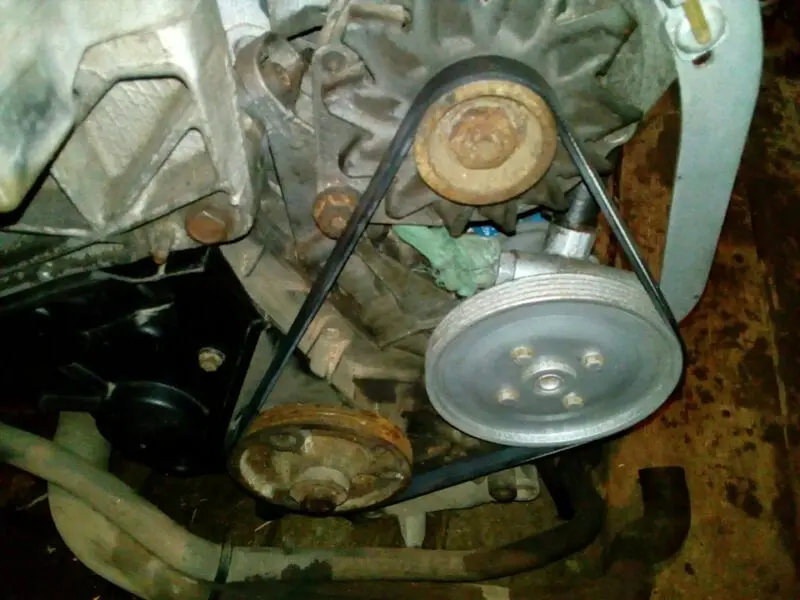

More modern pumps are equipped with an electronic pressure sensor that sends a signal to the ECU to open the valve at high pressure.
Power steering distributor
The distributor can be installed either on the steering shaft or on the steering gear drive. It directs the working fluid to the desired cavity of the hydraulic cylinder.
The distributor consists of:
- Torsion - a rod that works for twisting. One edge is inserted into the distributor shaft cavity, and the other is fixed inside the spool.
- Shaft is a hollow cylindrical element. It has channels for oil movement. It connects to the propeller shaft of the steering mechanism;
- The spool connected to the power steering shaft. At the other end, it is connected by a gear to the steering mechanism.
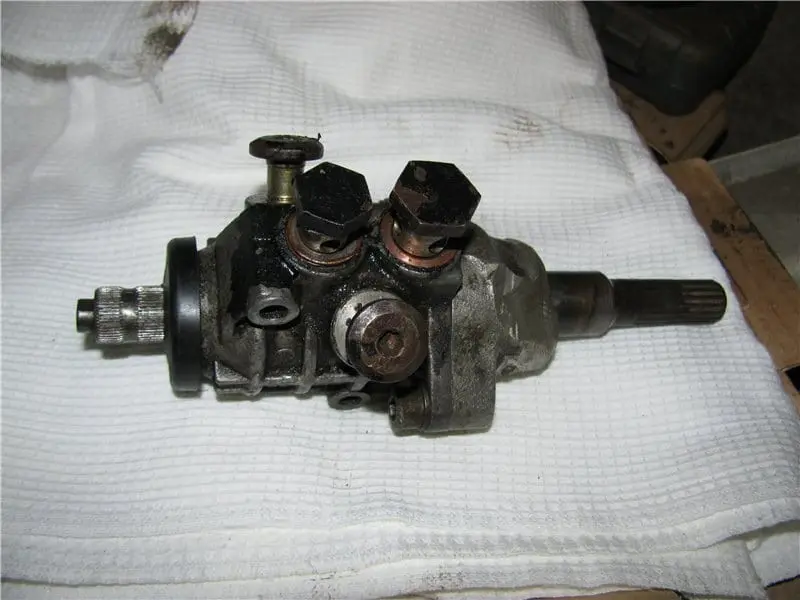

There are axial and rotary valve modifications. In the second case, the spool engages the steering rack teeth due to rotation around the shaft axis.
Hydraulic cylinder and connecting hoses
The hydraulic cylinder itself is a mechanism on which the pressure of the working fluid is applied. It also moves the steering rack in the appropriate direction, which makes it easier for the driver when performing maneuvers.
Inside the hydraulic cylinder there is a piston with a rod attached to it. When the driver starts to turn the steering wheel, an excess pressure is created in the cavity of the hydraulic cylinder (about 100-150 bar), due to which the piston begins to move, pushing the rod in the corresponding direction.
From the pump to the distributor and the hydraulic cylinder, the fluid flows through a high pressure hose. Often a metal tube is used instead for greater reliability. During idle circulation (tank-distributor-tank) oil flows through the low pressure hose.
Types of power steering
The modification of the power steering depends on the performance of the mechanism and its technical and dynamic characteristics. There are such types of power steering:
- Spool version - has a high efficiency, is used in budget cars and middle class models;
- The nozzle / damper option - among the disadvantages is low efficiency and requires more energy when the load increases. Due to such indicators, with the use of this modification of the power steering, the load on the power unit increases. They have high sensitivity, therefore they are most often used in bridge-type hydraulic boosters;
- The jet version has no frictional force in the valve cavity, and also has ease of use and durability. Such boosters are not whimsical to the quality of the oil;
- The electric option is a modern technology that works even when the engine is off. They are mainly installed on sports cars and premium cars.
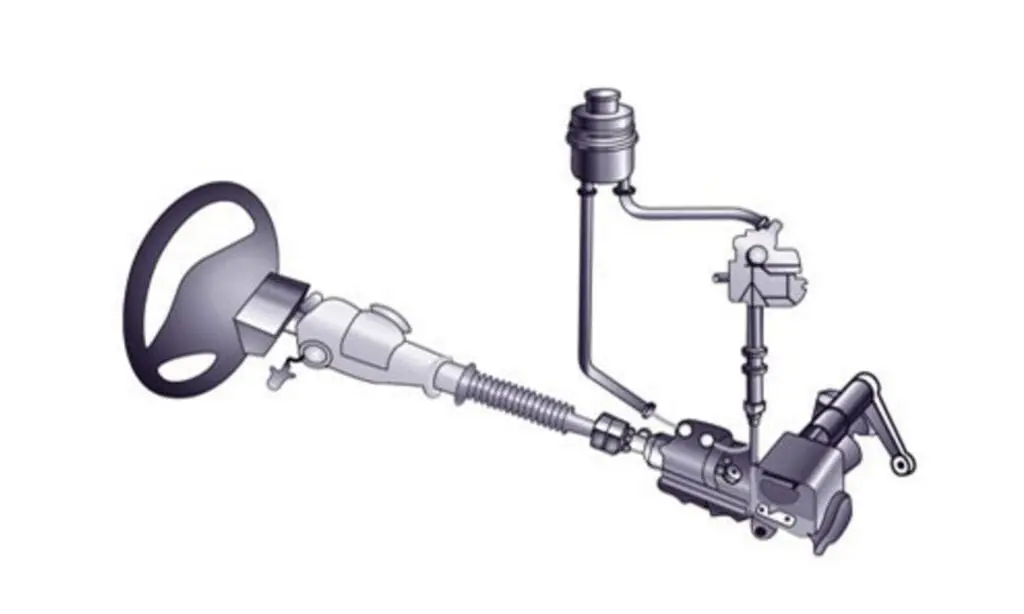

Some modern hydraulic power steering systems include a radiator to cool the working fluid.
Maintenance
The steering gear and hydraulic booster are reliable mechanisms in a car. For this reason, they do not need frequent and costly maintenance. The most important thing is to comply with the regulations for changing the oil in the system, which is determined by the manufacturer.
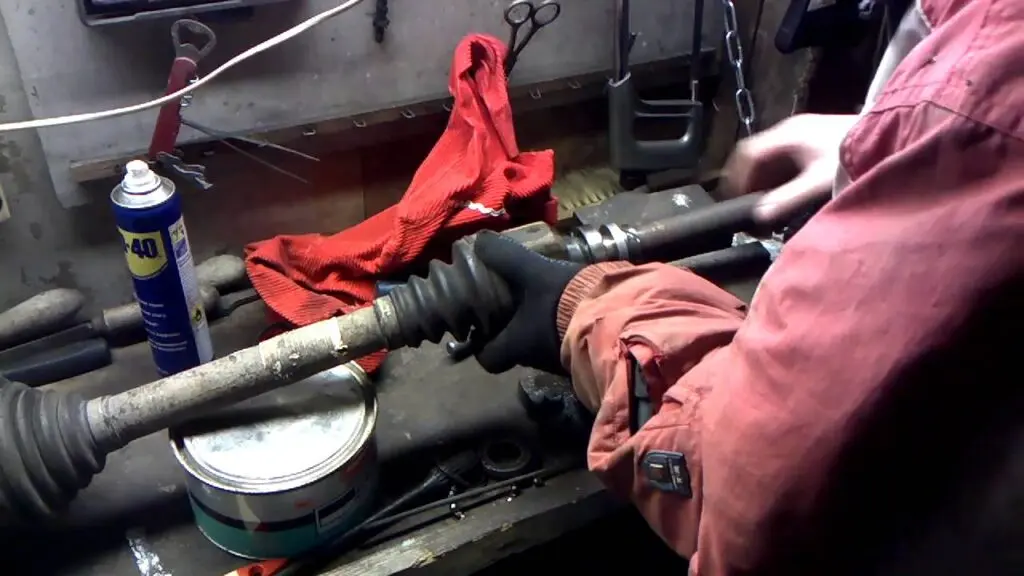

As a service to the power steering, it is necessary to periodically check the fluid level in the reservoir. If the level drops noticeably after adding the next portion of fluid, check for oil leaks at the hose connections or on the pump oil seal.
Frequency of fluid replacement in power steering
In theory, the hydraulic booster fluid is not under the aggressive influence of high temperatures, as in the engine or gearbox. Some drivers do not even think about periodically changing the oil in this system, except when the mechanism is being repaired.


Despite this, manufacturers recommend periodically changing the power steering oil. Of course, there are no hard boundaries, as is the case with engine oil, but this regulation depends on the intensity of the mechanism.
If a car drives about twenty thousand kilometers a year, then the fluid can be changed no more than once every three years. The reasons for periodic fluid changes are:
- Slight, but still heating of the oil during circulation along the line;
- Natural aging of the product;
- The appearance of foreign particles due to the development resulting from the friction of metal parts (the problem arises if the mechanism is made of low-quality materials).
If, when checking the oil level in the tank, the car owner hears the smell of burning oil, then it is already old and needs to be replaced.
Here is a short video on how the job is done correctly:


Watch this video on YouTube
Basic malfunctions and methods of elimination
Often, repairing the power steering boils down to replacing the seals. The work can be done by purchasing a power steering repair kit. Failure of the hydraulic booster is extremely rare and mainly due to fluid leakage. This is manifested in the fact that the steering wheel is spinning tightly. But even if the amplifier itself fails, the steering continues to function.
Here is a table of the main faults and their solutions:
| Malfunction | Why arises | Solution option |
| When driving, shocks from uneven surfaces are sent to the steering wheel | Poor tension or wear on the pump drive belt | Replace or tighten the belt |
| The steering wheel turns tight | The same problem with the belt; The level of the working fluid is below or close to the minimum value; A small number of revolutions of the crankshaft during idle operation; The filter in the reservoir is clogged; The pump creates weak pressure; The amplifier system is airing. | Change or tighten the belt; Replenish the fluid volume; Increase the engine speed (adjust); Change the filter; Restore the pump or replace it; Tighten the hose connections. |
| You need to make an effort to turn the steering wheel in the middle position | Mechanical pump failure | Replace the oil seal, repair the pump or replace it |
| Turning the steering wheel to one side requires a lot of effort | Pump defective | Repair the pump or replace the oil seal |
| It takes more effort to turn the steering wheel quickly | Poor drive belt tension; Low engine speed; Air system; Pump has broken. | Adjust the drive belt; Adjust the engine speed; Eliminate air leakage and remove the air plug from the line; Repair the pump; Diagnose the steering gear elements. |
| Decreased steering response | The fluid level has dropped; Airing of the power steering system; Mechanical failure of the steering rack, tire or other parts; Parts of the steering mechanism are worn out (not a problem with the power steering). | Eliminate the leak, fill up the lack of oil; Remove the airlock and tighten the connections so that no air is sucked in; Diagnostics and repair of the steering mechanism. |
| The hydraulic booster hums during operation | The oil level in the tank has dropped; The pressure relief valve is activated (the steering wheel is turned all the way). | Check for a leak, eliminate it and replenish the volume; Eliminate air bubbles; Check the pump is working properly; Check if the pump is sufficiently pressurized; Do not turn the steering wheel all the way. |
If the car is equipped with an electric booster, then in case of any alarm signals, you should immediately contact a specialist. The electronics are tested on the appropriate equipment, so without the necessary skills it is better not to try to repair something in the electrical system yourself.
Advantages and Disadvantages of Power Steering
Since modern comfort systems are designed to facilitate the driver's task in driving and make a long journey more enjoyable, then all the advantages of this system are associated with this:
- Facilitates maneuvers on narrow sections of the road or while parking a car;
- The driver is not so tired during long journeys;
- Softens ulars and vibrations that occur when driving on uneven roads;
- Provides more safety due to better steering response even at high speeds (especially when cornering).
Any additional comfort system has its drawbacks. The power steering has:
- Small loss of motor power, since the pump drive runs constantly;
- Periodically, although not often, the system needs maintenance.
In any case, the hydraulic booster makes the task of the modern motorist easier. Especially if the car is a truck.
Questions and answers:
How does power steering work? When the engine is running, fluid circulates around the circuit. At the moment the steering wheel rotates, the valve of one of the power steering cylinders opens (depending on the side of the turn). The oil presses on the piston and steering rack rod.
How to identify a power steering malfunction? Power steering malfunctions are accompanied by: knocking and backlash of the steering, changing efforts when turning, "biting" the steering wheel, unnatural position of the steering wheel relative to the wheels.
4 comment
cagsa.servicios@gmail.com
Good review, but does not mention at what pressure the system works
anonym
In this and similar cases, activity animation is best. Just a description ..is not enough, because most drivers do not know what system they have in their car and where
anonym
Possible malfunctions do not include the condition when the force required to turn the steering wheel copies the engine speed, the pump emits a squealing sound at high speeds and overheats. Is the pump safety valve the cause or another reason? Thank you in advance for your reply.
raze them
when the car reverses backwards, the steering feels heavy/hard. use a lot of energy to turn. what's the problem. sv5 car